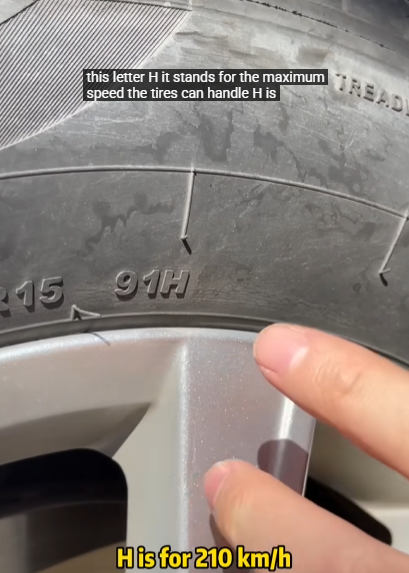
When most people look at car tires, they usually only think about their size, price, or perhaps the brand name printed on the side. But have you ever noticed that car tires are covered with numbers, letters, and symbols? To the untrained eye, they might look like random codes. In reality, these markings contain hidden information that can tell you almost everything you need to know about the tire—its size, strength, manufacturing date, performance rating, and even its safety limits. Understanding this information is not only fascinating but also crucial for driving safely and maintaining your car properly.
In this article, we’ll explore the hidden information in car tires, explain what each code means, and show you why it matters to every driver.
1. The Sidewall is a Treasure Map
If you look closely at the sidewall of a tire, you’ll see a mixture of letters and numbers molded into the rubber. These aren’t decorative—they are codes established by international standards, designed to give you all the technical details of the tire in one glance. The sidewall is essentially a “passport” of the tire.
For example, you might see something like this:
P215/65R15 95H
At first glance, it may look confusing, but each part tells a specific story.

2. Tire Type: The First Letter
The first character is often a letter that indicates the type of vehicle the tire is designed for:
- P – Passenger vehicle (most common for cars and SUVs).
- LT – Light Truck.
- ST – Special Trailer.
- If there is no letter, it may be a European metric tire used for passenger vehicles.
So, in our example, P215/65R15 95H, the “P” tells us it’s a passenger car tire.
3. Width, Aspect Ratio, and Diameter
Next comes a series of numbers and a letter: 215/65R15.
- 215 – This is the tire’s width in millimeters from sidewall to sidewall.
- 65 – The aspect ratio, which represents the height of the tire’s sidewall as a percentage of its width. A lower number means a lower profile (sportier look and handling).
- R – Stands for Radial construction, the most common type of tire today.
- 15 – This indicates the wheel diameter in inches.
So, 215/65R15 tells us that the tire is 215 mm wide, has a sidewall height that’s 65% of that width, is radial in design, and fits on a 15-inch rim.
4. Load Index and Speed Rating
Following the size, you’ll see a number and a letter: 95H.
- 95 – This is the load index, telling you how much weight the tire can carry. In this case, 95 means the tire can carry up to 690 kg (1521 lbs) when properly inflated.
- H – The speed rating, which tells you the maximum speed the tire is designed to handle. An “H” rating means up to 210 km/h (130 mph).
Other common speed ratings include:
- T = 190 km/h (118 mph)
- V = 240 km/h (149 mph)
- W = 270 km/h (168 mph)
- Y = 300 km/h (186 mph)
This means if you drive a high-performance sports car, choosing the right speed rating is not just a matter of comfort but also safety.

5. The DOT Code: Manufacturing Date and Plant
Another critical piece of hidden information is the DOT code. This code is required by the U.S. Department of Transportation but is also widely used globally. It usually looks something like:
DOT X0 AB 1A4 2923
Here’s what it means:
- The first few characters identify the manufacturer and plant where the tire was made.
- The last four digits are the week and year of production. In this example, “2923” means the tire was made in the 29th week of 2023.
This date is extremely important because rubber ages, even if a tire has never been used. Most experts recommend replacing tires that are more than 6–10 years old, regardless of tread wear. By checking the DOT code, you can make sure you’re not buying old stock.
6. Treadwear, Traction, and Temperature Ratings
Many tires also include a UTQG rating (Uniform Tire Quality Grading). It has three parts:
- Treadwear – A number that compares the durability of the tire. A tire with a treadwear rating of 400 should last twice as long as a tire rated 200 under controlled conditions.
- Traction – A letter grade (AA, A, B, C) showing how well the tire can stop on wet pavement.
- Temperature – A letter grade (A, B, C) showing the tire’s ability to resist heat at high speeds.
So, if you see Treadwear 500, Traction A, Temperature A, you know it’s a long-lasting tire with good wet grip and strong heat resistance.
7. Maximum Pressure and Load Information
On the sidewall, you’ll also find the maximum inflation pressure (e.g., “Max Press 51 PSI”) and maximum load capacity. This does not mean you should inflate your tires to this maximum pressure—it simply indicates the tire’s upper safety limit. The recommended tire pressure for your vehicle is usually found in the owner’s manual or on a sticker inside the driver’s door frame.
8. M+S and Snowflake Symbols
If you live in an area with changing weather, you may notice markings like M+S (Mud and Snow) or the Three-Peak Mountain Snowflake symbol (3PMSF).
- M+S means the tire is designed with a tread pattern suitable for light mud and snow.
- 3PMSF means the tire meets official winter performance standards and is reliable in severe snow conditions.
These symbols can help you choose the right tire for your climate.

9. Extra Markings: Reinforced, Run-Flat, and Directional Arrows
Tires may also include special markings:
- XL or Reinforced – Indicates the tire can handle heavier loads.
- Run-Flat – Means the tire can be driven for a limited distance even after a puncture.
- Directional Arrows – Show which direction the tire should rotate, ensuring optimal performance.
Ignoring these markings can lead to reduced handling, faster wear, or even safety risks.
10. Why Knowing This Hidden Information Matters
Understanding the hidden codes on your tires isn’t just for mechanics or car enthusiasts—it directly impacts your safety, comfort, and budget.
- Safety: Overloading a tire or driving beyond its speed rating can lead to blowouts.
- Savings: Choosing a tire with the right treadwear rating can save you money in the long run.
- Performance: The right speed and traction ratings ensure your car handles well in different conditions.
- Confidence: By checking the manufacturing date, you can avoid unknowingly buying old or expired tires.

11. Tips for Checking Your Tires Regularly
- Look at the DOT code to know the age of your tires.
- Check the tread depth with a coin or tread gauge—replace tires when tread is less than 2–3 mm.
- Maintain the correct air pressure as per your vehicle’s manual.
- Rotate your tires every 8,000–10,000 km for even wear.
- Inspect sidewalls for cracks, bulges, or unusual wear.
Conclusion
Car tires might look simple, but they’re packed with hidden information that every driver should know. From the size and load index to the manufacturing date and safety ratings, these codes can tell you whether a tire is safe, suitable for your vehicle, and reliable for the road ahead. Next time you look at your car’s tires, take a closer look—you’ll realize that those numbers and letters are more than just markings. They are the tire’s story, waiting to be read.
So, do you know the hidden information in your car tires now? If not, take a few minutes today to check your tires. Your safety and peace of mind depend on it.



